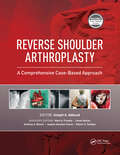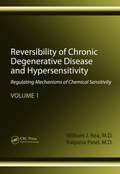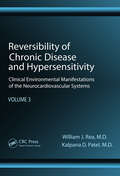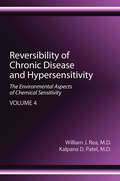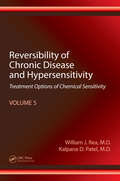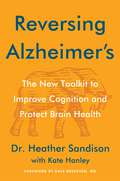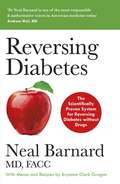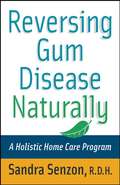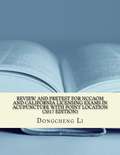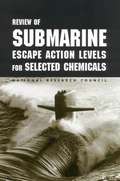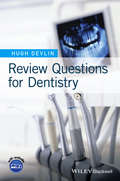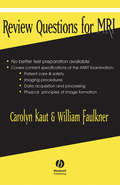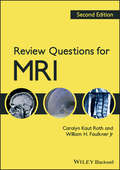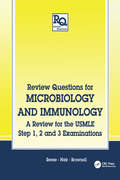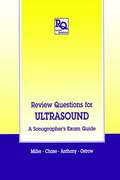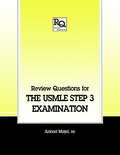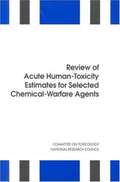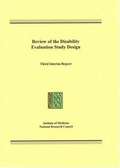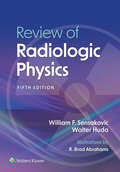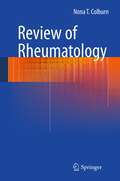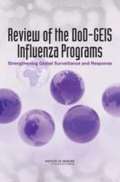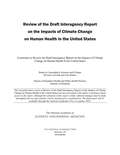- Table View
- List View
Reverse Shoulder Arthroplasty: A Comprehensive Case-Based Approach
by Joseph AbboudFocused on the rapidly expanding field of reverse shoulder arthroplasty, Reverse Shoulder Arthroplasty: A Comprehensive Case-Based Approach is a detailed guide for shoulder surgeons. As this type of arthroplasty continues to grow globally, this text fills the need for a comprehensive and current book on this topic. This text is edited by Dr. Joseph Abboud, alongside co-editors Drs. Frankle, Romeo, Sanchez-Sotelo, Neyton, and Tashjian. With dozens of leading orthopedic shoulder surgeons as contributors, Reverse Shoulder Arthroplasty: A Comprehensive Case-Based Approach serves the needs of a broad audience of surgeons. This includes fellowship-trained shoulder surgeons, sports surgeons, generalists, traumatologists, hand surgeons, and orthopedic oncologists. The unique, case-based approach highlights the current and historic principles of reverse shoulder arthroplasty. Important featured topics in Reverse Shoulder Arthroplasty include: Relevant anatomy, indications, and surgical approaches Theory of design and its practical applications: materials used, base plate design, glenospheres, and humeral stems Primary reverse shoulder arthroplasty: RSA for several different indications, how experts perform the operation, and techniques utilized in certain cases Revision reverse shoulder arthroplasty: step-by-step approach, evaluation of infection, instability, managing bone loss, and more Miscellaneous topics: various approaches to rehabilitation, salvage options, and non-arthroplasty options for the rotator cuff deficient shoulder Video website access is included with purchase, providing additional audio-visual support to theories and principles discussed in each chapter by the world’s leading experts.Reverse Shoulder Arthroplasty: A Comprehensive Case-Based Approach is a comprehensive and current guide intended to assist all levels of shoulder surgeons. This go-to resource will be a foundational asset to any surgeon in this expanding field.
Reverse Shoulder Arthroplasty: Current Techniques and Complications
by Stefano Gumina Federico Alberto Grassi Paolo PaladiniThis handbook fully investigates reverse shoulder arthroplasty (RSA), presenting all the recent advances in the field to enable shoulder surgeons to treat patients with complex conditions, such as rotator cuff tears and instability, failed surgery and combined arthritis, or proximal humerus neoplasia.Reverse shoulder arthroplasty is becoming increasingly common because conventional total shoulder replacement may cause pain, loss of strength, simple or complex disabilities as well as limited motion, reducing general quality of life. The goal of a reverse prosthesis is to restore a painless, biomechanically valid joint. Drawing on the results of recent studies, the book covers all relevant aspects of RSA, including basic science, pathogenesis, clinical and instrumental evaluation, surgical techniques and complication management, helping readers to better understand when and how reverse shoulder arthroplasty should be implanted and what to do in cases of poor results. Written by leading shoulder specialists, the book provides surgeons and rehabilitation specialists, as well as residents and shoulder fellows, with a valuable, state-of-the-art guide for clinical practice.
Reversibility of Chronic Degenerative Disease and Hypersensitivity, Volume 1: Regulating Mechanisms of Chemical Sensitivity
by William J. Rea Kalpana PatelThe clinical approaches to the chronic degenerative diseases that drain our resources, and compromise our well-being, have become almost exclusively symptom-focused. The common wisdom is that they are idiopathic with final outcomes to be managed rather than prevented or cured. That they are potentially reversible rarely enters into any discussion b
Reversibility of Chronic Disease and Hypersensitivity, Volume 3: Clinical Environmental Manifestations of the Neurocardiovascular Systems
by William J. Rea Kalpana PatelEncyclopedic in scope, Reversibility of Chronic Degenerative Disease and Hypersensitivity, Volume 3: Environmental Manifestations of the Neurocardiovascular Systems draws deeply from clinical histories of thousands of patients. It focuses on clinical syndromes within the musculoskeletal, neurological, and cardiovascular systems with a special focus
Reversibility of Chronic Disease and Hypersensitivity, Volume 4: The Environmental Aspects of Chemical Sensitivity
by William J. Rea Kalpana D. PatelReversibility of Chronic Disease and Hypersensitivity, Volume 4: The Environmental Aspects of Chemical Sensitivity is the fourth of an encyclopedic five-volume set describing the basic physiology, chemical sensitivity, diagnosis, and treatment of chronic degenerative disease studied in a 5x less polluted controlled environment. This text focuses on treatment techniques, strategies, protocols, prescriptions, and technologies. Distinguishing itself from previous works on chemical sensitivity, it explains newly understood mechanisms of chronic disease and hypersensitivity, involving core molecular function. The authors discuss new information on ground regulation system, genetics, the autonomic nervous system, and immune and non-immune functions. The book also includes the latest technology and cutting-edge techniques, numerous figures, and supporting research.
Reversibility of Chronic Disease and Hypersensitivity, Volume 5: Treatment Options of Chemical Sensitivity
by William J. Rea Kalpana D. PatelThe clinical approaches to the chronic degenerative diseases that drain our resources, and compromise our well-being, have become almost exclusively symptom-focused. The common wisdom is that they are idiopathic with final outcomes to be managed rather than prevented or cured. That they are potentially reversible rarely enters any discussion between doctor and patient. Reversibility of Chronic Disease and Hypersensitivity, Volume 5: Treatment Options of Chemical Sensitivity, the final volume of this set, offers a much different perspective on chronic degenerative disease; one that disputes the idiopathic label attached to most, as well as the usual fatalistic prognosis.
Reversibility of Chronic Disease and Hypersensitivity,Volume 2: The Effects of Environmental Pollutants on the Organ System
by William J. Rea Kalpana D. PatelEncyclopedic in scope, Reversibility of Chronic Degenerative Disease and Hypersensitivity, Volume 2: The Effects of Environmental Pollutants on the Organ System draws deeply from clinical histories of thousands of patients. It focuses on clinical syndromes within the musculoskeletal, gastrointestinal, and respiratory systems. The book explores mech
Reversing Alzheimer's: The New Toolkit to Improve Cognition and Protect Brain Health
by Heather SandisonA revolutionary and much-needed exploration of Alzheimer’s and how patients and their caregivers can take back control from this insidious disease.A significant portion of our population worries about the grip of dementia as we age. With over 6.5 million Americans living with Alzheimer's, the urgency for a solution has never been greater.Dr. Heather Sandison is at the forefront of dementia care and research. The founder of Solcere Health Clinic, San Diego’s premier brain optimization clinic, and Marama, the first residential memory care facility to have the goal of returning cognitively declined residents to independent living, Dr. Sandison knows better than most what Alzheimer’s does to people—to their brains, their bodies, their families, and their lives.If you're facing the challenge of Alzheimer's, either personally or as a caregiver, there is hope. A growing body of evidence shows that implementing a handful of strategies can improve cognition and quality of life in dementia patients. In Reversing Alzheimer's, Dr. Sandison lays out this customizable and doable approach so that you can start supporting you or your loved one's brain health right away.Within these pages, Dr. Sandison distills complex neurocognitive research into actionable steps, empowering you to:Fortify your brain health against cognitive declineImplement lifestyle changes that can reverse the effects of Alzheimer'sTransform your environment to support cognitive wellnessUnderstand options for brain health to fit any budgetDr. Sandison's expertise, derived from her clinical practice, residential care, and peer-reviewed research, charts the course for a future where Alzheimer's is not a terminal diagnosis, but a reversible condition. Reversing Alzheimer’s is an essential tool for anyone aspiring to rewrite their story and achieve a future free from the affliction of Alzheimer's.
Reversing Diabetes: The Scientifically Proven System for Reversing Diabetes without Drugs
by Dr Neal BarnardTackle diabetes and its complications for good with this newly updated edition of Dr. Neal Barnard's groundbreaking program.Revised and updated, this latest edition of Dr. Barnard's revolutionary guide to controlling your blood sugar features a new preface, updates to diagnostic and monitoring standards, recent research studies, and fresh success stories of people who have eliminated their diabetes by following this life-changing plan.Before Dr Barnard's scientific breakthrough (which predates almost every other book on blood sugar control), most health professionals believed that once you developed diabetes, you were stuck with it - and could anticipate one health issue after another, from worsening eyesight and nerve symptoms to heart and kidney problems. We know now that this is simply not true.Dr. Barnard has shown that it is possible to improve insulin sensitivity and tackle type 2 diabetes by following his step-by-step plan, which includes: ¦ a healthful vegan diet with plenty of recipes to get started¦ an easy-to-follow exercise guide¦ advice about taking supplements and tracking progress¦ troubleshooting tips¦ and more!It's a proven, tried and tested way to treat diabetes. And it's about time.
Reversing Gum Disease Naturally: A Holistic Home Care Program
by Sandra SenzonGum disease is the #1 oral health issue for Americans today-and simply brushing and flossing are not enough to avoid it. In this unique book, registered dental hygienist Sandra Senzon reveals how you can prevent and reverse gum disease through natural treatments. You'll get a new and broader understanding of your mouth as Senzon explains the causes of gum disease, along with the roles that stress, diet, and certain conditions such as diabetes can play in the onset of the disease. She shows you how to work with holistic products, set up an at-home hygiene center, and find the right professional to guide you in the natural reversal of gum disease. There's even a section for parents on how to help children practice good oral hygiene. Packed with expert tips and motivational strategies, Reversing Gum Disease Naturally will enable you to keep your gums and your teeth healthy and strong.
Review And Pretest For Nccaom And California Licensing Exams In Acupuncture With Point Location
by Dongcheng LiThis book is intended to aid students preparing for the National Certification Commission for Acupuncture and Oriental Medicine (NCCAOM) in Acupuncture with Point Locations module and, the California Acupuncture Licensing Examination. It is a concise review of Acupuncture and is intended to help the student recall material taught during the first and second years of Acupuncture school. It is not intended to substitute for comprehensive textbooks. The material is organized and divided into eight chapters. It will cover an Introduction to Acupuncture, the Twelve Primary Meridians and Their Acupoints, Eight Extra Meridians and Their Acupoints, Divergent Channels, Muscular-Sinew channels, Cutaneous Regions, Luo-connecting channels, Auricular and Scalp Acupuncture, Acupuncture Techniques, Acupuncture Treatment, Cautions of Acupoints, Regulations of States and NCCAOM, and Practice-related Issues. The knowledge points are summarized by words, concisely and clearly, with appropriate charts or pictures attached. Numerous practice questions reflecting the content and format of NCCAOM exam in Acupuncture with Point Location module are included after each chapter and six comprehensive examinations at the end of the book. These questions can be used as a pretest to identify areas of weakness or as a post test to determine mastery.
Review Of Submarine Escape Action Levels For Selected Chemicals
by Subcommittee on Submarine Escape Action LevelsThe National Academies Press (NAP)--publisher for the National Academies--publishes more than 200 books a year offering the most authoritative views, definitive information, and groundbreaking recommendations on a wide range of topics in science, engineering, and health. Our books are unique in that they are authored by the nation's leading experts in every scientific field.
Review Questions for Dentistry
by Hugh DevlinReview Questions for Dentistry is an essential exam practice tool designed for undergraduate dentistry students, postgraduate MJDF candidates, and overseas candidates sitting their OREs. Using the questions as a platform for learning consolidation, this exam preparation guide provides feedback to students to enable them to assess their knowledge and understanding of the subject. Features multiple question formats including MCQs, EMQs, SAQs and find the missing word questions Answers include detailed explanations to help expand and consolidate learning The text is divided into two sections; introductory questions and questions exploring the subjects in more detail The book is accompanied by a companion website offering further interactive self-assessment tools
Review Questions for MRI
by William H. Faulkner Jr. Carolyn Kaut RothMagnetic Resonance Imaging (MRI) is the fastest growing modality in diagnostic imaging. There are now thousands of MRI facilities across the United States and around the world, employing huge numbers of technologists. The American Registry of Radiologic Technologists has, with the help of experts in the MRI and educational fields, devised a multiple choice examination that is intended to ensure that all technologists have the required level of knowledge to practice MRI safely and competently. Carolyn Kaut and William Faulkener, experts in the field of MRI education, have compiled this book to help students prepare for the registry examination. The questions follow the structure of the syllabus and are intended to help readers test their understanding of the subject and identify any gaps in their knowledge. The book is extremely comprehensive, covering all the aspects of the examination, including patient care and safety, imaging procedures, pulse sequences and data acquisition, and imaging artifacts and options.
Review Questions for MRI
by William H. Faulkner Jr. Carolyn Kaut Roth** New revised second edition now available, with errors corrected and content fully updated ** The second edition of the classic text has been revised and extended to meet the needs of today’s practising and training MRI technologists who intend to sit for the American Registry of Magnetic Resonance Imaging Technologists (ARMRIT) examination. It provides Q&As on topics listed in the content specifications offered by the American Registry for Radiologic Technologists (AART) and offers the user with a comprehensive review of the principles and applications of MRI to prepare them for the examination.
Review Questions for Microbiology and Immunology: A Review for the USMLE, Step 1, 2 and 3 Examinations
by A.C. Reese C.N. Nair G.H. BrownellThis is a review text on medical microbiology and immunology containing approximately 625 board-type review questions on left-hand pages with answers and explanations on facing right-hand pages. It is designed for medical students taking microbiology as well as for those studying for Step 1 of the National Board Exams and is also useful for Step 3
Review Questions for Ultrasound: A Sonographer's Exam Guide
by J.A. MillerThis is a comprehensive, large-format review text with complete answers for the American national examination of the Registry of Diagnostic Medical Sonographers (RDMS). It contains 600 questions divided evenly between sections on physics, the abdomen and small parts, and obstetrics and gynecology. The authors combine many years of experience teaching diagnostic ultrasound and provide illustrative scans and drawings for added comprehension.
Review Questions for the USMLE, Step 3 Examination
by Arshad MajidThe United States Medical Licensing Examination (USMLE) Step 3 is the final step of the USMLE examination series. The focus of the Step 3 examination is on the clinical sciences, physical examination, data interpretation, and appropriate management in different clinical settings. Review Questions for The USMLE Step 3 Examination contains over 400 'high yield' questions carefully written to cover the material typically found on the actual exam, allowing you to identify areas that need greater focus in your preparation. In addition, like the actual exam, this review book contains high quality color plates in a special section of the book. It is clearly not possible for any text to cover all the material encountered on the actual examination. However, there are certain topics, because of their clinical importance, that are examined year after year. Providing coverage of favorite USMLE topics and an easy-to-use layout, this book familiarizes you with the format of the examination and the areas that need further study in your overall preparation. You can work through this book piece by piece, focusing on the subjects in any order that is convenient for you. Or you may work through the book by simulating the examination and becoming familiar with the format and time limit. Review Questions for the USMLE Step 3 Examination helps you focus and plan the time you need to study, and the areas in which you should put most of your efforts.
Review of Acute Human-Toxicity Estimates for Selected Chemical-Warfare Agents
by Subcommittee on Toxicity Values for Selected Nerve Vesicant AgentsA Review of Acute Human-Toxicity Estimates for Selected Chemical-Warfare Agents
Review of Disability Evaluation Study Design: Third Interim Report
by Committee to Review the Social Security Administration's Disability Decision Process ResearchThe National Academies Press (NAP)--publisher for the National Academies--publishes more than 200 books a year offering the most authoritative views, definitive information, and groundbreaking recommendations on a wide range of topics in science, engineering, and health. Our books are unique in that they are authored by the nation's leading experts in every scientific field.
Review of Radiologic Physics
by William SensakovicOffering a complete review for radiology residents and radiologic technologists preparing for certification, Review of Radiologic Physics, 5th Edition, by Dr. William F. Sensakovic, is a high-yield, efficient resource for today’s clinically focused exams. Now fully up to date, this edition covers x-ray production and interactions, projection and tomographic imaging, image quality, radiobiology, radiation protection, nuclear medicine, ultrasound, and magnetic resonance—all of the important physics information you need to understand the factors that improve or degrade image quality.
Review of Rheumatology
by Nona T. ColburnReview of Rheumatology is a synopsis of key areas of interest, making for an indispensable quick reference work. The material included reviews basic musculoskeletal anatomy, immunology, genetics, major rheumatic diseases and their pathophysiology, and major rheumatic therapeutics, as well as a unique chapter on the emerging autoinflammatory diseases. Review of Rheumatology is a clear and concise review book written in an outline format. This book is a quick and easily accessible reference not only for those preparing for the rheumatology board exams, but it also serves as a succinct reference for all health care workers interested in the field of rheumatology.
Review of the Department of Defense Enhanced Particulate Matter Surveillance Program Report
by National Research Council of the National AcademiesSoldiers deployed during the 1991 Persian Gulf War were exposed to high concentrations of particulate matter (PM) and other airborne pollutants. Their exposures were largely the result of daily windblown dust, dust storms, and smoke from oil fires. On returning from deployment, many veterans complained of persistent respiratory symptoms. With the renewed activity in the Middle East over the last few years, deployed military personnel are again exposed to dust storms and daily windblown dust in addition to other types of PM, such as diesel exhaust and particles from open-pit burning. On the basis of the high concentrations observed and concerns about the potential health effects, DOD designed and implemented a study to characterize and quantify the PM in the ambient environment at 15 sites in the Middle East. The endeavor is known as the DOD Enhanced Particulate Matter Surveillance Program (EPMSP). The U.S. Army asked the National Research Council to review the EPMSP report. In response, the present evaluation considers the potential acute and chronic health implications on the basis of information presented in the report. It also considers epidemiologic and health-surveillance data collected by the USACHPPM, to assess potential health implications for deployed personnel, and recommends methods for reducing or characterizing health risks.
Review of the DoD-GEIS Influenza Programs: Strengthening Global Surveillance and Response
by Institute of Medicine of the National AcademiesThe National Academies Press (NAP)--publisher for the National Academies--publishes more than 200 books a year offering the most authoritative views, definitive information, and groundbreaking recommendations on a wide range of topics in science, engineering, and health. Our books are unique in that they are authored by the nation's leading experts in every scientific field.
Review of the Draft Interagency Report on the Impacts of Climate Change on Human Health in the United States
by Engineering Medicine National Academies of ScienceThe U.S. National Climate Assessment (NCA; Melillo et al., 2014) identified a number of ways in which climate change is affecting or is likely to affect, people, infrastructure, natural resources, and ecosystems. Those impacts in turn have the potential for important current and future consequences for human health. Research on these impacts is active, with strong evidence to support some aspects and research still in progress for others. Therefore, there is a need to assess our understanding of how the impacts of climate change on the environment can create stressors that can affect human health in a number of dimensions both now and in the future. <P> In response to this need, the U.S. Global Change Research Program (USGCRP) has initiated an interagency Assessment on the Impacts of Climate Change on Human Health in the United States. The Assessment is intended to inform public health authorities, other planning and policy entities, and the general public. It extends the work begun under the 2008 Synthesis and Assessment Product 4.6 (USGCRP, 2008) Analyses of the Effects of Global Change on Human Health and Welfare and Human Systems and the third NCA released in 2014.
